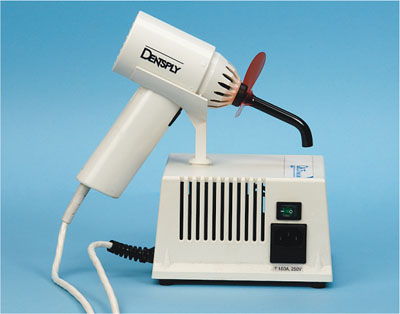Chapter 8
Dental Curing Lights
Aim
The aim of this chapter is to improve knowledge of the types of dental curing lights available and their clinical use.
Outcome
Readers will know the relevance of dental curing light irradiance, the advantages and disadvantages of the different types of machine and curing modes available and how to maintain machine performance.
Introduction
Dental curing lights are devices that generate bright light, the energy of which initiates the photopolymerisation of a wide range of light-cured restorative materials. The majority of light-cured restorative materials contain cam-phorquinone as the photoinitiator. Light with a wavelength of 468 nm is required to initiate polymerisation. A limited number of light-cured materials contain alternative photoinitiators, for example phenyl propanedione (PPD), which requires light with a wavelength of 410 nm to initiate polymerisation (Park et al., 1999). This photoinitiator is sometimes chosen as an alternative to camphorquinone because of its colour stability, which limits “yellowing” of the restoration in clinical service. Alternative photoinitiators are sometimes found in low-viscosity surface sealant materials.
The light output of a curing unit is described as irradiance, and is the power output per surface area of the curing tip (mW/cm2). Irradiance varies between 600 and 2400 mW/cm2, dependent on the type of curing light used. The amount of energy available to polymerise a material is called the energy density – the product of irradiance and time. Therefore, if the irradiance is reduced, it must be compensated for by a longer light exposure time, and vice versa.
Irradiance is reduced under the following conditions:
-
low-powered curing light
-
larger-diameter curing light guide
-
batteries in cordless models in need of recharge
-
deterioration in light output of bulb, or ageing, damage or fogging of filters and mirror reflectors
-
contamination of curing guide tip by debris, such as polymerised dental materials.
Irradiance can be quantified by means of a radiometer, which is specific for the generic type of curing light. Radiometers can be simple hand-held devices containing a photosensitive diode, or can be built into the curing light. It is recommended that a baseline reading is taken when purchasing a new unit. Irradiance is subsequently checked weekly, and a log kept to determine when it is falling. When a fall in irradiance is detected, steps should be taken to remedy the problem. An alternative method of checking irradiance is to test cure a specimen of dental material in a specially produced mould. In general, these moulds enable an assessment to be made of the depth of material that is being polymerised by the light output. This is a subjective test, which is not always accurate or reproducible; however, it is better than not testing. The output of curing lights can be assessed visually.
The use of a curing light with inadequate irradiance runs the risk of producing restorations with a so-called “soggy bottom” – cured on the surface but still soft at the base. This will lead to early clinical failure, in particular if the “soggy bottom” is located along a cervical margin. Inadequate curing of material will also lead to leaching of uncured resin. This may result in an adverse soft tissue or possibly even a systemic reaction. Other consequences of incomplete curing include increased susceptibility to wear, poor colour stability and possible early breakdown of adhesive bonds.
The energy density required to polymerise a material will increase when:
-
The distance from the tip of the light guide to the surface of the material is increased.
-
Dark shades of material are used.
-
There is polymerisation of certain microfilled composites, which increase light scattering.
-
There is polymerisation of flowable composites, which require a higher energy density than hybrid composites.
Under these circumstances, the depth of polymerisation will be reduced and should be compensated for by the placement of thinner increments of material and extending curing times.
Types of Dental Curing Light Available
There is a very wide range of different curing lights available; they vary greatly in cost, number of features, weight, power output and maintenance requirements, among other features. The most commonly used curing lights are:
-
halogen light-curing units – also known as quartz-tungsten-halogen or QTH units
-
LED (light-emitting diode) units.
Much less commonly used forms of curing units include:
-
plasma arc units
-
argon lasers.
Halogen Curing Lights
For many years halogen light-curing units were the most common form of curing light in clinical practice. However, LED curing lights are now increasingly replacing halogen units. An example of a halogen curing light is shown in Fig 8-1.

Fig 8-1 Example of a halogen curing light.
Halogen lights have certain advantages; they:
-
are relatively cheap
-
have a long, reliable track record
-
emit a broad range of light wavelengths (400–510 nm) and are therefore capable of photopolymerising a wide range of light-cured dental materials
-
are available in corded or cordless versions.
The disadvantages of halogen light-curing units include the following:
-
The units are inefficient as over 99% of the light output is not in the wavelengths required; this includes light in the infrared range, which generates heat. This heat is in addit/>
Stay updated, free dental videos. Join our Telegram channel

VIDEdental - Online dental courses


